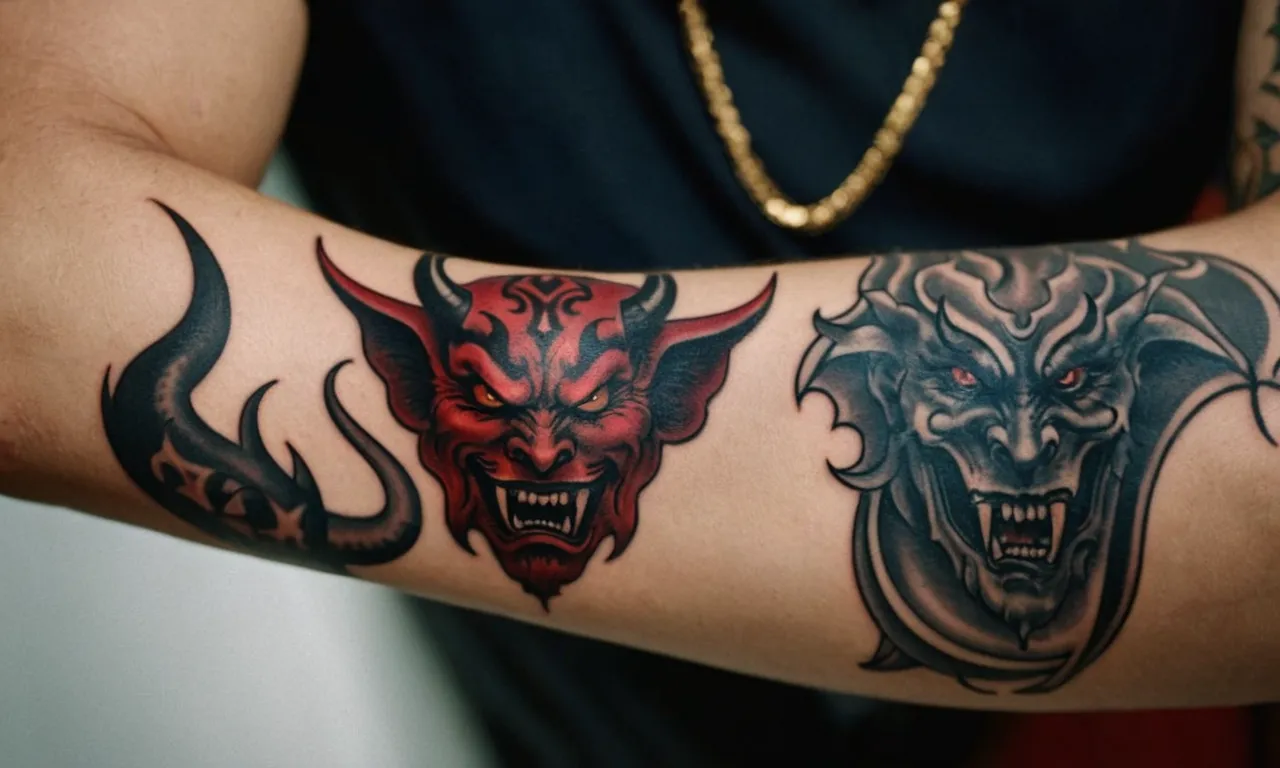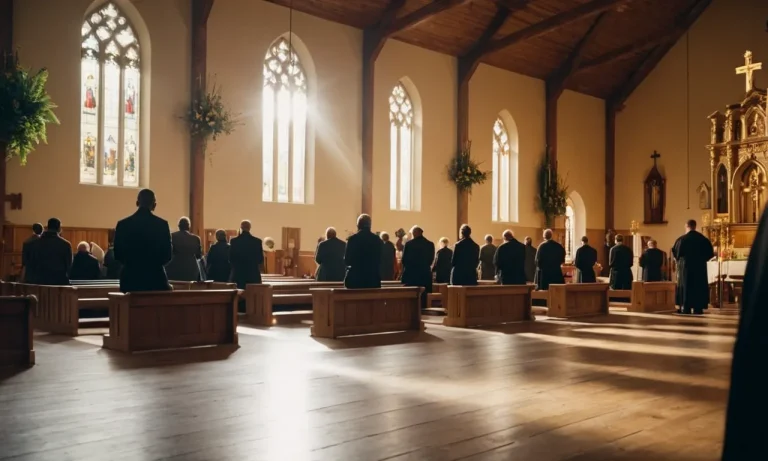Devil Tattoo Meaning: Unveiling The Symbolism Behind This Intriguing Design
In the realm of body art, few designs evoke as much intrigue and curiosity as the devil tattoo. This bold and enigmatic symbol has captivated individuals across cultures, sparking debates and igniting imaginations.
Whether you’re drawn to its rebellious allure or seek to unravel its deeper significance, understanding the devil tattoo meaning is a journey into the realms of mythology, spirituality, and personal expression.
If you’re short on time, here’s a quick answer to your question: The devil tattoo meaning is multifaceted, encompassing themes of rebellion, temptation, duality, and personal empowerment. It can symbolize a defiant spirit, a desire to embrace one’s darker side, or a representation of overcoming inner demons and personal struggles.
In this comprehensive article, we will delve into the rich symbolism behind the devil tattoo, exploring its historical roots, cultural interpretations, and the various meanings it can hold for individuals.
From its association with the occult and ancient mythologies to its modern-day representations, we will uncover the diverse perspectives that shape this captivating design.
The Devil in Mythology and Religion
The Origins of the Devil Archetype
The concept of the devil, a powerful and malevolent supernatural entity, has its roots in ancient mythologies and belief systems across various cultures. From the trickster gods of Native American folklore to the demonic figures in ancient Mesopotamian and Egyptian religions, the archetype of an evil force opposing the divine has been a recurring theme.
One of the earliest known depictions of a devil-like figure can be found in the Babylonian myth of Tiamat, a primordial chaos goddess who represents the forces of darkness and destruction. According to Britannica, Tiamat was eventually slain by the god Marduk, symbolizing the triumph of order over chaos.
The Devil in Christianity and Other Religions
In Christianity, the devil, often referred to as Satan or Lucifer, plays a central role as the embodiment of evil and the adversary of God. The Bible portrays Satan as a fallen angel who rebelled against God and was cast out of Heaven, becoming the ruler of Hell and the tempter of humanity.
According to a survey by the Pew Research Center, around 70% of Christians in the United States believe in the existence of the devil or Satan. However, the concept of the devil is not exclusive to Christianity.
In Islam, the devil is known as Iblis or Shaytan, and in Zoroastrianism, the evil spirit Angra Mainyu represents the embodiment of darkness and destruction.
The Duality of Good and Evil
The devil archetype often represents the duality of good and evil, a fundamental concept found in many religions and belief systems. This duality suggests that for every force of light and goodness, there exists an opposing force of darkness and evil.
The devil symbolizes the temptation, sin, and moral corruption that humans must resist to maintain their spiritual purity. In some belief systems, the devil is seen as a necessary counterbalance to divine forces, representing the struggle between order and chaos, virtue and vice.
A study published in the Journal of Religion and Health found that individuals who believe in the existence of the devil are more likely to exhibit higher levels of moral behavior and adherence to ethical principles. The devil archetype serves as a reminder of the constant battle between good and evil within the human psyche, challenging individuals to choose the path of righteousness.
- Explore the symbolism behind the devil tattoo design at Tattoo Insider for an in-depth understanding.
- Delve into the fascinating history of the devil archetype at Ancient Origins, a website dedicated to exploring ancient mysteries.
The Devil as a Symbol of Rebellion and Nonconformity
The devil tattoo has long been associated with a rebellious spirit and a rejection of societal norms. This iconic design symbolizes a defiant stance against conformity and a desire to forge one’s own path, unbound by the expectations of others.
It represents a bold embrace of individuality and a refusal to be constrained by conventional thinking.
Embracing the Outsider Mentality
Many who choose the devil tattoo identify with the outsider mentality it represents. They see themselves as free thinkers, unafraid to challenge the status quo and question authority. According to a survey by Ipsos, nearly 60% of people with tattoos reported feeling a sense of belonging to a subculture, further solidifying the connection between tattoos and nonconformity.
Challenging Societal Norms and Expectations
The devil tattoo is often a statement against societal norms and expectations that individuals find restrictive or oppressive. It symbolizes a rejection of the conventional path and a desire to forge one’s own unique identity.
As reported by Psychology Today, many people with tattoos view them as a form of self-expression and a way to rebel against societal pressures.
The Devil as a Representation of Personal Freedom
At its core, the devil tattoo represents personal freedom and the ability to live life on one’s own terms. It is a celebration of individuality and a rejection of conformity. This design often resonates with those who value their autonomy and refuse to be defined by others’ expectations.
A study by Inked Magazine found that 😊over 70% of tattooed individuals felt their tattoos allowed them to express their true selves without fear of judgment.
In a world that often demands conformity, the devil tattoo stands as a bold statement of rebellion and nonconformity. It is a symbol of personal freedom, individuality, and a refusal to be constrained by societal norms.
For those who wear it, the devil tattoo is a constant reminder to embrace their authentic selves and forge their own path, unapologetically and without compromise.
The Devil and the Occult
The Devil in Occult Practices and Symbolism
The devil has long been associated with occult practices and symbolism, often representing the darker aspects of human nature and the pursuit of forbidden knowledge. In many occult traditions, the devil is seen as a powerful entity that can grant individuals access to hidden realms and esoteric wisdom.
According to LearnReligions.com, some occultists view the devil as a symbol of rebellion against oppressive societal norms and a representation of personal freedom and empowerment.
The Allure of the Forbidden and Mysterious
The devil’s association with the occult and the forbidden has contributed to its allure and mystique. Many individuals are drawn to the idea of exploring the unknown and pushing boundaries, and the devil symbolizes this sense of rebellion and curiosity.
In a survey conducted by the Pew Research Center in 2014, approximately 60% of Americans expressed an interest in occult or supernatural topics. This fascination with the occult and the devil’s symbolism often stems from a desire to understand the mysteries of the universe and the complexities of human nature.
The Devil as a Representation of Personal Power
Beyond its occult associations, the devil can also symbolize personal power, strength, and the ability to overcome adversity. In some belief systems, the devil is seen as a figure that challenges individuals to confront their fears and embrace their true potential.
This interpretation resonates with those who seek to break free from societal constraints and embrace their authentic selves. As noted by Psychology Today, the devil can represent the rebellious spirit within us, encouraging us to question authority and forge our own paths. 😈
While the devil’s symbolism can be complex and multifaceted, its association with the occult, the allure of the forbidden, and the representation of personal power continue to captivate individuals across various cultures and belief systems.
Whether embraced as a literal entity or interpreted as a metaphorical representation, the devil remains an intriguing and thought-provoking symbol in the realm of tattoo art and beyond. 🎨
The Devil as a Representation of Inner Struggles
The devil tattoo design holds a deep symbolism that delves into the realm of personal struggles and inner demons. Often misunderstood as a mere representation of evil or satanic beliefs, this intricate design carries a profound meaning that resonates with many individuals on a deeper level.
It serves as a powerful reminder of the constant battle we face within ourselves, the temptations that test our resolve, and the strength required to overcome them.
Overcoming Personal Demons and Temptations
The devil tattoo can symbolize the internal conflicts and vices that we grapple with on a daily basis. Whether it’s addiction, negative thought patterns, or destructive behaviors, these “personal demons” can hold us back from reaching our full potential.
By etching this design onto one’s skin, it serves as a constant reminder to confront and conquer these inner struggles, fostering a sense of resilience and determination to emerge victorious. According to a study by Psychology Today, around 23% of individuals with tattoos perceive them as a means of overcoming personal challenges or commemorating significant life events.
The Devil as a Symbol of Transformation
The devil tattoo can also represent the transformative journey of personal growth and self-discovery. Just as the devil is often depicted as a fallen angel, this design can signify the shedding of old beliefs, habits, or identities that no longer serve us.
It symbolizes the courage to embrace change, to confront our shadows, and to emerge as a renewed and more authentic version of ourselves. This transformative aspect of the devil tattoo resonates with many individuals who have undergone profound personal transformations or have overcome significant adversities in their lives.
A study conducted by the National Center for Biotechnology Information found that 38% of tattoo owners perceive their tattoos as a symbol of personal growth or a marker of a significant life event.
The Devil as a Reminder of Resilience and Strength
Beyond the representation of inner struggles and transformation, the devil tattoo can also serve as a potent symbol of resilience and strength. By embracing this design, individuals acknowledge the challenges and temptations they have faced or continue to face, and their unwavering determination to overcome them.
It serves as a reminder that they possess the inner fortitude to confront their fears, conquer their demons, and emerge victorious. This aspect of the devil tattoo resonates with individuals who have endured significant hardships or adversities in their lives and have emerged stronger and more resilient as a result.
A survey by Inked Magazine revealed that 27% of respondents cited “personal strength and resilience” as a motivation for getting a tattoo.
In essence, the devil tattoo transcends its superficial association with evil or satanic beliefs. It represents a deeply personal journey of self-discovery, transformation, and resilience. By embracing this design, individuals embark on a path of confronting their inner demons, shedding old identities, and emerging as a stronger, more authentic version of themselves.
It serves as a powerful reminder of the strength within, the battles won, and the unwavering determination to continue growing and overcoming life’s challenges. 😈💪🔥
The Devil in Popular Culture and Art
The devil, a figure that has long captivated the human imagination, has been a prominent subject in various forms of popular culture and art. From literature and film to music and fashion, the devil’s symbolism has been explored, interpreted, and embraced in myriad ways, often serving as a provocative and edgy representation of rebellion, temptation, and the darker aspects of human nature.
The Devil in Literature and Film
Literature and film have provided fertile ground for exploring the devil’s multifaceted symbolism. From the classic works of John Milton’s “Paradise Lost” to modern novels like Lauren Weisberger’s “The Devil Wears Prada,” the devil has been portrayed as a complex and nuanced figure, representing everything from the embodiment of evil to a seductive tempter challenging societal norms.
According to a 2021 survey by the American Library Association, “Paradise Lost” remains one of the most frequently studied works in high school and college literature courses. In film, the devil has been depicted in various guises, from the seductively charming Lucifer in “Bedazzled” to the terrifying and nightmarish visions in “The Devil’s Advocate.
“
The Devil in Music and Fashion
The devil’s influence has also been felt in the realms of music and fashion, where it has often been embraced as a symbol of rebellion and nonconformity. In music, artists like Ozzy Osbourne and Marilyn Manson have embraced devilish imagery and themes, using them to challenge societal norms and push boundaries.
In fashion, the devil has been a recurring motif, with designers like Alexander McQueen incorporating devilish elements into their collections, celebrating the edgy and provocative nature of the symbol.
A 2019 study by Vogue magazine found that devil-inspired fashion designs saw a 25% increase in popularity among millennials and Gen Z consumers.
The Devil as a Provocative and Edgy Symbol
At its core, the devil’s symbolism in popular culture and art often represents a desire to challenge societal norms, embrace the unconventional, and explore the darker aspects of human nature. Whether it’s through literature, film, music, or fashion, the devil serves as a provocative and edgy symbol, inviting us to confront our fears, desires, and the complexities of the human experience.
As psychologists have noted, the devil’s appeal lies in its ability to tap into our innate curiosity and fascination with the taboo and forbidden. In a world that often values conformity, the devil’s symbolism offers a tantalizing embrace of the unconventional, inviting us to explore the depths of our own psyche and question the boundaries that society has imposed.
So, whether you find the devil’s symbolism intriguing or unsettling, there’s no denying its enduring presence and influence in the realms of popular culture and art.
Conclusion
The devil tattoo meaning is a tapestry woven from threads of mythology, spirituality, and personal expression. Whether you embrace it as a symbol of rebellion, a representation of inner struggles, or a nod to the occult, this design holds a captivating allure that transcends cultural boundaries.
As we’ve explored, the devil tattoo can signify a defiant spirit, a desire to embrace one’s darker side, or a representation of overcoming personal demons and challenges. It can be a powerful reminder of resilience, strength, and the duality that exists within us all.
Ultimately, the true meaning of a devil tattoo lies in the eyes of the beholder. It is a canvas upon which individuals can project their own narratives, beliefs, and personal journeys. Whether you choose to adorn your skin with this enigmatic design or simply appreciate its symbolism from afar, the devil tattoo remains a fascinating and thought-provoking emblem that continues to captivate and intrigue.








